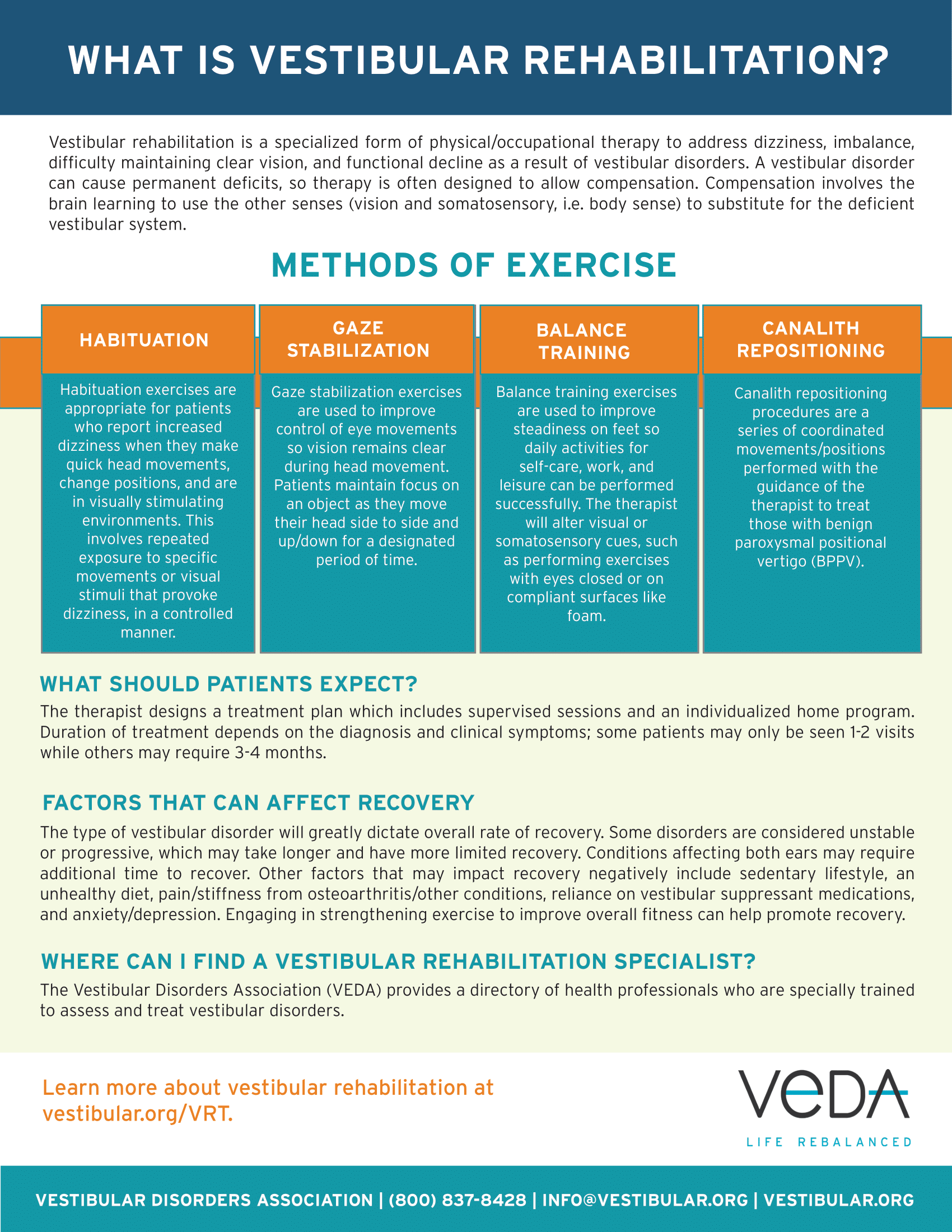Vestibular Rehabilitation Therapy
Vestibular rehabilitation therapy is a specialized treatment designed to reduce or eliminate symptoms of dizziness and vertigo. Feeling dizzy or off-balance is a common complaint among individuals 40 and over. In addition, more than 1/3 of US adults have experienced some form of vestibular dysfunction. A concussion can also cause a vestibular disorder.
Balance and Vestibular Dysfunction
Balance is especially important for daily life and is controlled by the integration of 3 separate systems
1) Vision
2) Vestibular system (inner ear)
3) Proprioception (our sense of touch and positional self-awareness)
Sensory information from these 3 systems is processed by the brain stem. The brain stem sends motor signals to the eyes to maintain steady vision; as well as, to the spinal muscles to maintain balance and posture.
What is the Vestibular System?
The vestibular system consists of the central (brain and brain stem) and peripheral (inner ear and pathways to the brain stem) pathways. The role of the vestibular system is to process sensory information involved with controlling balance and eye movements. In addition, the vestibular system also functions as a judge, determining the correct information when our visual and proprioceptive inputs differ.
Our vision provides most of the information relating to our balance. When the information from our eyes and proprioception differs (i.e. seeing a passing train while sitting in a car at a railroad crossing may cause a sensation of moving) the vestibular system acts as a tie-breaker between the two conflicting systems. When the vestibular system is not functioning properly, it is no longer able to resolve these sensory conflicts. A dysfunctional vestibular system results in symptoms such as: dizziness, vertigo and disequilibrium.
Symptoms of Vestibular Dysfunction
- Vertigo: Illusion of movement; sensation that the environment is spinning around an individual (subjective vertigo), or the individual is spinning in space (objective vertigo).
- These symptoms can present with movement or sitting still in specific positions.
- Dizziness: sensation of lightheadedness, faintness or floating.
- Feeling of being rocked (similar to being on a boat), or a sensation of being pulled in one direction.
- Disequilibrium: is a loss of equilibrium or feeling of being off-balance
- Difficulty walking straight or turning that results in a tendency to look at the ground
Visual Symptoms of a Vestibular Disorder
Visual symptoms of a vestibular disorder include difficulty of the eyes to maintain focus (vergence) or track an object (smooth pursuits and saccades). An example of this is patients may report difficulty reading as words on a page may appear to jump, blur or become doubled.
Visual motion sensitivity (VMS) is another possible symptom of a vestibular disorder (indication of an optokinetic nystagmus). Patients with VMS tend to be symptomatic when they are in busy visual environments, such as: grocery stores, traffic or crowds.
Eye-tracking technology (i.e. Saccade Analytics) is the most accurate way of testing for visual dysfunctions (vergence, smooth pursuits, saccades and optokinetic nystagmus) that occur as a result of a vestibular disorder.
It is important that patients with visual symptoms of a vestibular disorder visit their optometrist first to rule out any structural changes in their vision and receive vision therapy if necessary.
What is Vestibular Rehabilitation Therapy?
Vestibular rehabilitation therapy (VRT) involves a series of diagnostic tests and corrective exercises. The goal of VRT is to reduce symptoms of dizziness, vertigo and improve balance.
Vestibular rehabilitation therapy has been shown to help with a number of vestibular disorders, including:
- Benign Paroxysmal Positional Vertigo (BPPV)
- Cervicogenic dizziness
- Unilateral or bilateral vestibular hypofunction (reduced inner ear function on one or both sides)
- Ménière’s disease
- Labyrinthitis
- Vestibular neuritis
- Persistent Postural-Perceptual Dizziness (PPPD)
Vestibular Rehabilitation Therapy Exercises
- Habituation: Exercises tailored for patients who report increased dizziness with quick head movements, changes in position and exposure to visually stimulating environments (Optokinetic Nystagmus).
- Gaze Stabilization: Exercises designed to improve control and co-ordination between the eyes and vestibular system (vestibular ocular reflex); as well as, the eyes and the cervical spine (cervical ocular reflex).
- Balance Training: Exercises tailored to improve balance to increase competency with daily activities; such as: self-care, work and leisure.
- Canalith Repositioning: Series of coordinated movements designed to treat individuals with benign paroxysmal positional vertigo (BPPV).
Vestibular Information and flyers obtained from VEDA.


Contact Us
Sports Rehab & Wellness
Waterloo Region, Ontario, Canada, Waterloo Region, Ontario, N2M 2L3
Call Us: (226) 752-9533
sportsrehabandwellness.ca
Visit Us
Green Base Health Consulting
22 Water Street South,
Kitchener, ON N2J 1C4
